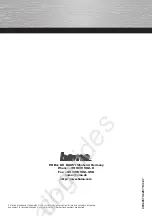
4
Xantrex Lithium-ion Battery Owner's Guide
Important Safety Information
READ AND SAVE THIS
O
WNER
'
S
G
UIDE FOR FUTURE
REFERENCE
.
This guide contains important safety instructions for the Xantrex
Battery that must be followed during installing, operating,
configuring, maintaining, and troubleshooting.
Read these instructions carefully and look at the equipment to
become familiar with the device before installing, operating,
configuring, maintaining, and troubleshooting it. The following
special messages may appear throughout this documentation or
on the equipment to warn of potential hazards or to call attention
to information that clarifies or simplifies a procedure.
The addition of either symbol to a “Danger” or
“Warning” safety label indicates that an electrical
hazard exists which will result in personal injury if the
instructions are not followed.
This is the safety alert symbol. It is used to alert you
to potential personal injury hazards. Obey all safety
messages that follow this symbol to avoid possible
injury or death.
DANGER
DANGER
indicates a hazardous situation which, if not avoided,
will result in
death or serious injury.
WARNING
WARNING
indicates a hazardous situation which, if not avoided,
could
result in
death or serious injury.
CAUTION
CAUTION
indicates a hazardous situation which, if not avoided,
could
result in
minor or moderate injury.
NOTICE
NOTICE
is used to address practices not related to physical injury.
Please Note
No responsibility is assumed by Xantrex for any consequences
arising out of the use of this material.
DANGER
HAZARD OF ELECTRIC SHOCK,
EXPLOSION, BURN, OR ARC
FLASH
ARC FLASH
HAZARD
c
An example of an arc flash event
could be a direct short circuit caused
by a metallic object such as a tool
bridging between the positive and
negative of an energized circuit.
n
This battery shall be installed and serviced only by
qualified personnel.
n
Always wear proper PPE (safety glasses and clothing)
when working on the Li-ion battery and follow safe
electrical work practices according to local codes.
n
Do not wear metallic items such as watches or bracelets
when working on the battery. Use insulated tools to
prevent accidental short circuit.
n
Do not install the Li-ion battery module adjacent to any
heat source. Keep away from sources of ignition.
n
Do not install or operate any of the system devices in a
compartment containing flammable materials or in
locations that require ignition-protected equipment.
n
Do not use in vital, medical, or life-support applications.
n
No user-serviceable parts. Do not attempt to open or
dismantle the Li-ion battery. If the battery module is
damaged, do not touch the toxic electrolyte or powder,
and consult your dealer.
n
When the battery module is damaged, it can release
harmful gases. Ensure the surrounding environment is
well-ventilated.
n
In case battery content comes in contact with skin or eyes,
immediately flush the affected area with large amount of
clean water and seek medical help.
n
In case of fire, use only a Class ABC (dry chemical) or
CO
2
type fire extinguisher. Water can be a dangerous
extinguishing medium for energized equipment because
of the risk of electric shock.
n
Dispose of Li-ion batteries through a local recycling
center. Do not mix batteries with other wastes. Contact
your local recycling center for proper disposal
information.
n
Do not crush, puncture, drop, disassemble, or dispose of
in fire.
Failure to follow these instructions will result in death or
serious injury.
WARNING
HAZARD OF FIRE, ELECTRIC SHOCK, EXPLOSION,
AND PERSONAL INJURY
n
Do not expose the Li-ion battery to rain, snow, or liquids of
any type. Products are designed for indoor use only.
n
Do not step on the battery module.
n
Always use proper lifting techniques when handling the
battery module. Battery is heavy.
n
Do not charge the battery in ambient temperature below
freezing.
n
Do not disconnect the battery while it is being charged.
Failure to follow these instructions can result in death, serious
injury, or equipment damage
.





































